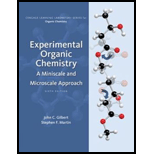
Interpretation:Thewave number for C-C stretching vibration needs to be determined, given that vibration for C=C is 1640 cm-1.The wave number for carbon -carbon triple bond needs to be determined wherein the k is appropriate multiple of carbon-carbon double bond.
Concept introduction:
There is large variance in force constant with small differences in bond length. The wavenumber is inversely proportional to square root of reduced mass. Hence, when there is increase in reduced mass, there is decrease in wave numbers.
Answer to Problem 4E
The wave number for C-C bond is 1159.6 cm-1 and stretching frequency of C-C triple bond is 2009 cm-1.
Explanation of Solution
The relation between wave number and reduced mass is depicted in equation
ˉν=12πc√km*...............(1)
Where
ˉν = wave numberk = force constantm* = reduced massc = speed of light
Computing for reduced mass, the equation is
m* = mc x mcmc + mc................(2)
Where
mc = atomic mass of carbon
Substituting
m* = 12g x 12g12g + 12 g=144g24g=6g
From equation (1), all the factors are constant except reduced mass and the reduced mass is inversely proportional to square root of reduced mass.
ˉνC−CˉνC=C=√k(C−C)m*(C−C)k(C=C)m*(C−C).....................(3)
Where,
ˉνC−C stands for wave number for single bondsˉνC=C stands for wave number for double bonds
But given that k(C=C)=2k(C−C) and ˉνC=C=1640 cm−1
ˉνC−CˉνC=C=√k(C−C)m*(C−C)k(C=C)m*(C−C)ˉνC−C1640cm−1=√k(C−C)m*(C−C)2k(C−C)m*(C−C) ˉνC−C1640cm−1= 0.707cm−1ˉνC−C=1159.65cm−1
It is known that force constant for C-C triple bond is three times that of C-C single bond.
k(C=C)=2k(C−C)k(C−C)=k(C=C)2
Hence, computing for C-C triple bonds.
k(C≡C)=3k(C−C)=3k(C=C)2
k(C≡C)=3k(C=C)2
For triple bond, the equation is
ˉνC≡CˉνC=C=√k(C≡C)m*(C−C)k(C=C)m*(C−C)=√3k(C=C)m*(C−C)2k(C=C)m*(C−C)ˉνC−C1640cm−1= √32=1.224ˉνC−C = 2008.6cm−1
Hence, the stretching frequency of C-C triple bond is 2009cm-1.
Thus, the wave number for C-C bond is 1159.6 cm-1 and stretching frequency of C-C triple bond is 2009 cm-1.
Want to see more full solutions like this?
Chapter 8 Solutions
Experimental Organic Chemistry: A Miniscale & Microscale Approach (Cengage Learning Laboratory Series for Organic Chemistry)
- In the decomposition reaction in solution B → C, only species C absorbs UV radiation, but neither B nor the solvent absorbs. If we call At the absorbance measured at any time, A0 the absorbance at the beginning of the reaction, and A∞ the absorbance at the end of the reaction, which of the expressions is valid? We assume that Beer's law is fulfilled.arrow_forward> You are trying to decide if there is a single reagent you can add that will make the following synthesis possible without any other major side products: 1. ☑ CI 2. H3O+ O Draw the missing reagent X you think will make this synthesis work in the drawing area below. If there is no reagent that will make your desired product in good yield or without complications, just check the box under the drawing area and leave it blank. Click and drag to start drawing a structure. Explanation Check ? DO 18 Ar B © 2025 McGraw Hill LLC. All Rights Reserved. Terms of Use | Privacy Center | Accessibilityarrow_forwardDon't use ai to answer I will report you answerarrow_forward
- Consider a solution of 0.00304 moles of 4-nitrobenzoic acid (pKa = 3.442) dissolved in 25 mL water and titrated with 0.0991 M NaOH. Calculate the pH at the equivalence pointarrow_forwardWhat is the name of the following compound? SiMe3arrow_forwardK Draw the starting structure that would lead to the major product shown under the provided conditions. Drawing 1. NaNH2 2. PhCH2Br 4 57°F Sunny Q Searcharrow_forward
- 7 Draw the starting alkyl bromide that would produce this alkyne under these conditions. F Drawing 1. NaNH2, A 2. H3O+ £ 4 Temps to rise Tomorrow Q Search H2arrow_forward7 Comment on the general features of the predicted (extremely simplified) ¹H- NMR spectrum of lycopene that is provided below. 00 6 57 PPM 3 2 1 0arrow_forwardIndicate the compound formula: dimethyl iodide (propyl) sulfonium.arrow_forward
 Physical ChemistryChemistryISBN:9781133958437Author:Ball, David W. (david Warren), BAER, TomasPublisher:Wadsworth Cengage Learning,
Physical ChemistryChemistryISBN:9781133958437Author:Ball, David W. (david Warren), BAER, TomasPublisher:Wadsworth Cengage Learning, Principles of Modern ChemistryChemistryISBN:9781305079113Author:David W. Oxtoby, H. Pat Gillis, Laurie J. ButlerPublisher:Cengage Learning
Principles of Modern ChemistryChemistryISBN:9781305079113Author:David W. Oxtoby, H. Pat Gillis, Laurie J. ButlerPublisher:Cengage Learning


